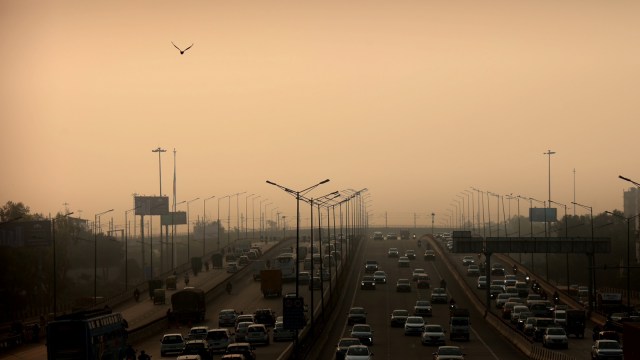Delhi chokes, but 15 of 35 power units in 300-km radius don’t treat sulphur dioxide
Panipat and Yamuna Nagar plants are operated by the Haryana Power Generation Corporation Limited (HPGCL), Guru Hargobind and Ropar by Punjab State Power Corporation Limited (PSPCL), and Talwandi Sabo plant by Vedanta.
 A smog-filled afternoon in Delhi on Saturday. (Photo: Amit Mehra)
A smog-filled afternoon in Delhi on Saturday. (Photo: Amit Mehra)EVEN AS Delhi’s air quality deteriorates, many units of thermal power plants in a 300 km radius of the capital city, continue to operate without flue gas desulphurisation (FGD) systems, which are critical for reducing sulphur dioxide emissions. Sulphur dioxide causes fine particulate matter PM2.5; it reacts with other compounds in the air to form air particles with a diameter of 2.5 micrometers or less, which are not visible to the naked eye.
An analysis of Central Electricity Authority (CEA) data from November 1-19 shows there are at least 15 units across six thermal plants within Delhi’s 300 km radius which do not have a FGD system and were operating throughout this period. These include four units in Haryana (two each in Yamuna Nagar and Panipat thermal power stations), and 11 units in Punjab (three in Talwandi Sabo, and four each at the Guru Hargobind and Ropar thermal power stations).
Panipat and Yamuna Nagar plants are operated by the Haryana Power Generation Corporation Limited (HPGCL), Guru Hargobind and Ropar by Punjab State Power Corporation Limited (PSPCL), and Talwandi Sabo plant by Vedanta.
Overall, there are a total of 11 thermal power plants comprising 35 units (a single plant typically has multiple units) located within the 300 km radius of the national capital. Of these 35 units, only 13 had FGD systems installed in April 2025, said an affidavit submitted by the Commission for Air Quality Management to the National Green Tribunal. Installation in the remaining 22 units is at different stages and may take up to 36 months to complete, it said.
In recent months, the Indira Gandhi Super Thermal Power Plant in Jhajjar, Haryana, installed the FGD system in its one remaining unit. This reduces the total number of units causing sulphur dioxide pollution to 21.
The CEA’s November 1-19 data, analysed by The Indian Express, shows that 15 of these 21 units, which have not installed FGD systems, were operational during the month. The remaining six were not operational. These are two at Rajiv Gandhi Thermal Power Station (TPS), one at Panipat TPS, and three at Harduaganj TPS in Aligarh, Uttar Pradesh. Most have been placed under “reserve shutdown,” meaning they were shut down due to low demand, some were off the grid due to annual maintenance or other technical issues.
Sulphur dioxide which is emitted when coal is burnt in thermal power plants is harmful for human health, environment and climate. While FGD systems reduce its emissions, compliance has been slow. Experts attribute it to two reasons – some units are exempted from sulphur dioxide emission norms, and yet others keep getting time relaxations.
Exemptions are decided according to the category a unit falls under as defined by the Ministry of Environment, Forests and Climate Change. Coal plants were put in three buckets in April 2021 by the ministry. Category A included plants within 10 km of the National Capital Region or million-plus cities; Category B covered those within 10 km of critically polluted or non-attainment areas; and Category C all remaining plants outside these zones.
Responding to a query, both PSPCL and Vedanta said their units were exempt from setting up FGD systems since their plants belonged to ‘Category C’. Other operators did not respond.
In fact, seven out of the 11 thermal power plants within the 300-km radius of Delhi, and accounting for 21 units, fall under Category C; most of these have not installed the FGD system in their units.
To reduce pollution levels, the ministry issued the country’s first sulphur dioxide, nitrogen oxide, and mercury standards for coal plants in December 2015. Operators were given two years to install SO₂ control systems like FGD. But since most plants missed the deadline, more time was granted, with plants in NCR getting four extensions, and plants elsewhere thrice.
In September 2022, the deadline was extended and then given further relaxation in July this year. Under the latest notification, the deadline for Category A plants to install FGD is December 2027, for Category B plants December 2028, and Category C plants are exempt from installing FGD systems, as long as the height of their chimneys (stacks) meet required limits.
PSPCL said four units each of Guru Hargobind and Ropar met the stack height criteria as per the July notification.
A 2024 study by the Centre for Research on Energy and Clean Air (CREA), a global independent research organisation, estimates SO₂ emissions from all 11 thermal plants within the 300-km radius of Delhi to be 16 times higher than the emissions from paddy stubble burning. Full FGD installation across the cluster could cut SO₂ emissions in Delhi–NCR by 67 per cent, it said.
“SO₂ emission from these TPPs travels far beyond the plant boundary,Yet, only 14 units within 300 km of Delhi are required to install pollution-control systems, while 21 can operate without them, allowing SO₂ to escape daily. If stubble burning is blamed for polluting Delhi because its smoke crosses state borders, why aren’t power plants—whose emissions travel just as far—treated with the same seriousness,” said Manoj Kumar N, an analyst with CREA, and author of the report.







